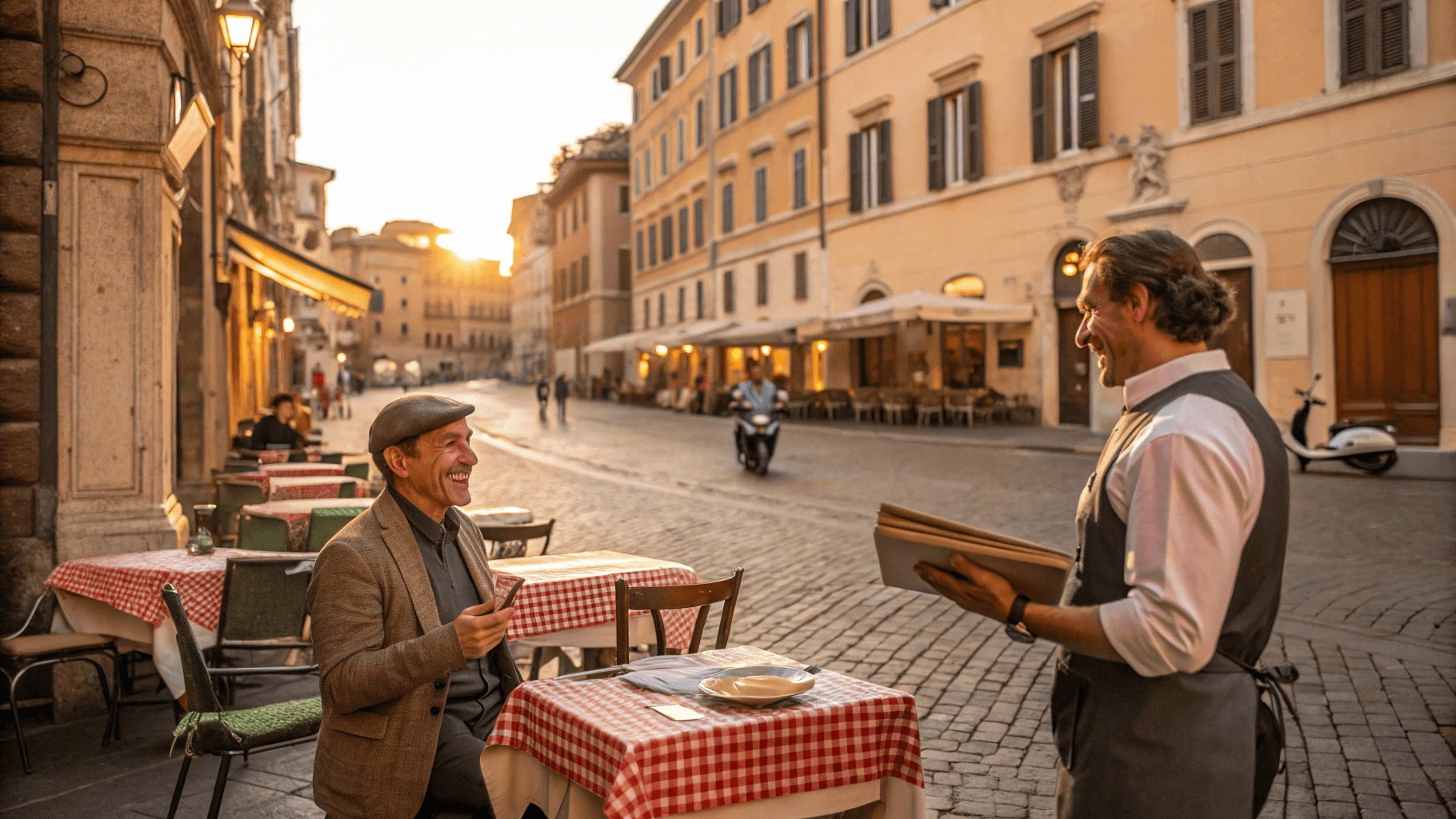Traveling to Italy soon? This comprehensive guide tackles both aspects of “travel in Italian” – learning key Italian phrases AND understanding how to use them effectively throughout your Italian adventure. Whether you’re planning to explore Rome’s ancient streets or wander through Tuscan vineyards, this guide will enhance your experience by helping you connect more authentically with locals and navigate Italy with confidence.
Table of Contents
Why Bother with Basic Italian?
When planning your Italian adventure, you might wonder if learning some basic Italian is worth the effort. After all, isn’t English widely spoken in major tourist destinations?
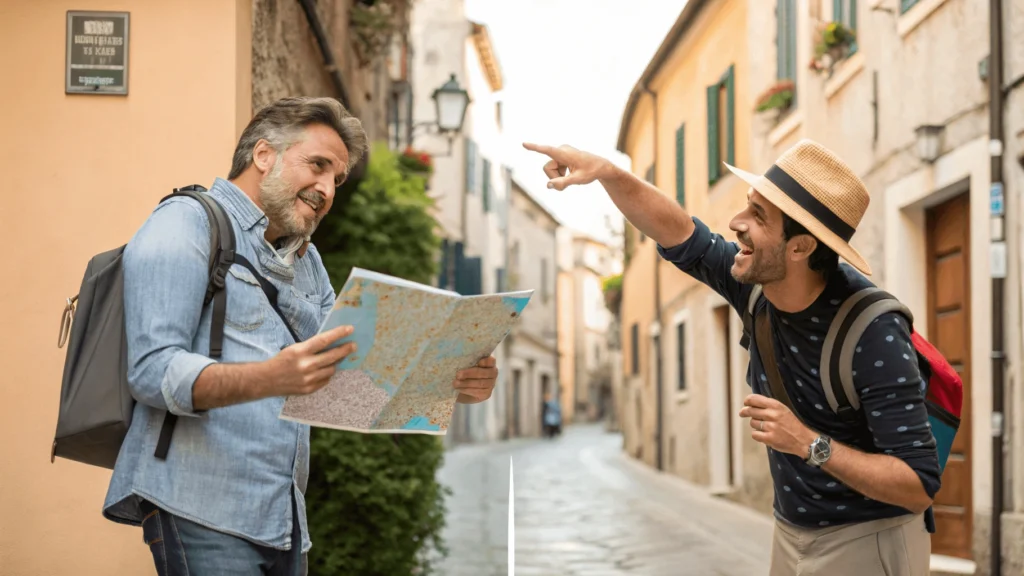
While you can certainly get by with English in places like Rome, Florence, and Venice (particularly in hotels and restaurants catering to tourists), there are compelling reasons to learn some basic Italian phrases: “travel in italian”
- Deeper cultural immersion – Even simple exchanges in Italian create meaningful connections with locals that enrich your travel in Italian experience
- Smoother interactions – Navigate day-to-day situations more easily, especially in smaller towns and rural areas where English is less common
- Show respect – Italians appreciate visitors who make an effort to speak their language, often resulting in warmer welcomes and better service
- Handle minor issues – Solve small problems without always needing to find an English speaker
- Enhance your travel stories – Those moments when you successfully communicated in Italian often become cherished travel memories
Remember, Italians don’t expect perfection – just a genuine effort. Even if you only master the basics, locals will appreciate your attempt to embrace their beautiful language. For a deeper understanding of why language matters in travel in Italian, the U.S. State Department highlights how even basic local language skills can improve your safety and cultural connections abroad
The Core Italian Phrasebook for Travelers
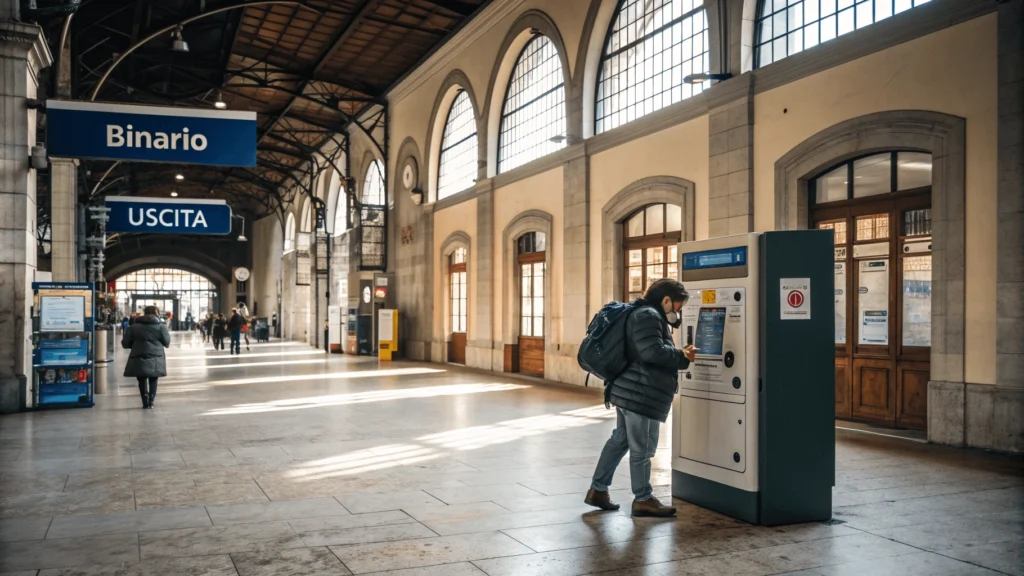
Greetings & Basic Courtesy”travel in italian”
| Italian | Pronunciation | English | When to Use |
|---|---|---|---|
| Ciao | chow | Hello/Goodbye | Informal greeting for friends, young people, casual settings |
| Buongiorno | bwon-JOOR-noh | Good morning/day | Formal greeting until early afternoon |
| Buonasera | bwon-ah-SAY-rah | Good evening | Formal greeting from late afternoon onward |
| Arrivederci | ah-ree-veh-DEHR-chee | Goodbye | Standard formal goodbye |
| Grazie | GRAH-tsyeh | Thank you | Essential – use generously! |
| Prego | PREH-goh | You’re welcome/Please | Multipurpose: responds to “grazie” or precedes requests |
| Scusi | SKOO-zee | Excuse me | Getting attention politely or apologizing |
| Mi dispiace | mee dees-PYAH-cheh | I’m sorry | More formal apology |
Common Mistake: Many tourists only use “Ciao” for every greeting. While friendly, this can be too casual in formal settings. Use “Buongiorno” or “Buonasera” with shopkeepers, waiters, or older Italians to show respect.
Essential Questions & Phrases
| Italian | Pronunciation | English |
|---|---|---|
| Parla inglese? | PAR-lah een-GLEH-zeh? | Do you speak English? |
| Non capisco | non kah-PEES-koh | I don’t understand |
| Come si dice…? | KOH-meh see DEE-cheh? | How do you say…? |
| Dov’è il bagno? | doh-VEH eel BAH-nyoh? | Where is the bathroom? |
| Quanto costa? | KWAHN-toh KOSS-tah? | How much does it cost? |
| Aiuto! | ah-YOO-toh! | Help! |
| Mi serve… | mee SAIR-veh | I need… |
| Ho bisogno di… | oh bee-ZOH-nyoh dee | I need… (more formal) |
Numbers “travel in italian”
Knowing basic numbers helps with everything from shopping to understanding prices:
- Uno, due, tre, quattro, cinque (1-5)
- Sei, sette, otto, nove, dieci (6-10)
- Venti, trenta, quaranta, cinquanta (20, 30, 40, 50)
- Cento, mille (100, 1000)
Directions
| Italian | Pronunciation | English |
|---|---|---|
| A destra | ah DES-trah | To the right |
| A sinistra | ah see-NEES-trah | To the left |
| Dritto | DREET-toh | Straight ahead |
| Vicino | vee-CHEE-noh | Near |
| Lontano | lon-TAH-noh | Far |
| Dove si trova…? | DOH-veh see TROH-vah? | Where is…? |
Accommodation Phrases
| Italian | Pronunciation | English |
|---|---|---|
| Ho una prenotazione | oh OO-nah preh-noh-tah-TSYOH-neh | I have a reservation |
| C’è il WiFi? | cheh eel WEE-fee? | Is there WiFi? |
| La chiave, per favore | lah KYAH-veh, pehr fah-VOH-reh | The key, please |
| A che ora è la colazione? | ah keh OH-rah eh lah koh-lah-TSYOH-neh? | What time is breakfast? |
Dining Essentials “travel in italian”
| Italian | Pronunciation | English |
|---|---|---|
| Un tavolo per due, per favore | oon TAH-voh-loh pehr DOO-eh, pehr fah-VOH-reh | A table for two, please |
| Il menu, per favore | eel meh-NOO, pehr fah-VOH-reh | The menu, please |
| Un bicchiere di vino rosso/bianco | oon beek-KYEH-reh dee VEE-noh ROSS-oh/BYAHN-koh | A glass of red/white wine |
| Il conto, per favore | eel KOHN-toh, pehr fah-VOH-reh | The bill, please |
| Buono! | BWOH-noh! | Delicious! |
Shopping Phrases
| Italian | Pronunciation | English |
|---|---|---|
| Solo sto guardando | SOH-loh stoh gwar-DAHN-doh | I’m just looking |
| Che taglia è? | keh TAH-lyah eh? | What size is it? |
| Posso provarlo? | POSS-soh proh-VAHR-loh? | Can I try it on? |
| Accettate carte di credito? | ah-chet-TAH-teh CAR-teh dee CRED-ee-toh? | Do you accept credit cards? |
Emergency Phrases “travel in italian”
| Italian | Pronunciation | English |
|---|---|---|
| Aiuto! | ah-YOO-toh! | Help! |
| Chiamate un’ambulanza! | kyah-MAH-teh oon-ahm-boo-LAHN-tsah! | Call an ambulance! |
| Ho perso il mio passaporto | oh PEHR-soh eel MEE-oh pass-ah-POR-toh | I’ve lost my passport |
| Mi sono perso/a | mee SOH-noh PEHR-soh/sah | I’m lost |
| Sono allergico/a a… | SOH-noh al-LEHR-jee-koh/kah ah… | I’m allergic to… |
Pro Tip: Save emergency phrases in your phone where you can access them quickly without internet connection.
Putting it into Practice: Navigating Italy Essentials
Knowing phrases is one thing; knowing when and how to use them is another. Let’s walk through typical travel in Italian situations and how your new Italian skills can help. “travel in italian”

Arrival & Basics “travel in italian”
When you first arrive at an Italian airport or train station, these scenarios are common:
- Getting a taxi: “Taxi, per favore” is all you need to start, followed by your destination: “All’Hotel [name], per favore” or “Via [street name], per favore”
- Asking if someone speaks English: Always start with “Buongiorno” or “Buonasera” then “Parla inglese?”
- Buying a bus/metro ticket: “Un biglietto, per favore” (one ticket) or “Due biglietti, per favore” (two tickets)
Cultural Tip: Always begin interactions with a greeting. Launching straight into a question or request without saying “Buongiorno” first can come across as rude to Italians.
Getting Around
Italy’s transportation system is extensive but can be confusing for first-timers:
Train travel in Italian:
- Buying tickets: At automated machines (which usually have English options) or ticket windows where you can say “Vorrei un biglietto per [destination], per favore”
- Validating tickets: Always remember to validate your ticket in the small machines before boarding regional trains (say “Dov’è la validatrice?” if you can’t find it), For regional and national train schedules, ticket booking, and traveler tips, consult Italy’s official railway site Trenitalia
- Finding your platform: “Da quale binario parte il treno per [destination]?”
Navigation: “travel in italian”
- When asking for directions, start with “Scusi, dov’è…” followed by your destination
- Listen for key direction words: “dritto” (straight), “a destra” (right), “a sinistra” (left)
- For distances, understand “vicino” (near) versus “lontano” (far)
Common Signs:
- “Uscita” – Exit
- “Entrata” – Entrance
- “Vietato” – Forbidden
- “Chiuso/Aperto” – Closed/Open
- “Spingere/Tirare” – Push/Pull
Accommodation
At your hotel or rental apartment:
- Checking in: “Ho una prenotazione a nome [your name]”
- Asking about facilities: “C’è il WiFi?” (Is there WiFi?), “A che ora è la colazione?” (What time is breakfast?)
- Reporting issues: “Il condizionatore non funziona” (The air conditioner isn’t working), “Non c’è acqua calda” (There’s no hot water)
- Checking out: “Vorrei fare il check-out, per favore”
Dining Decoded
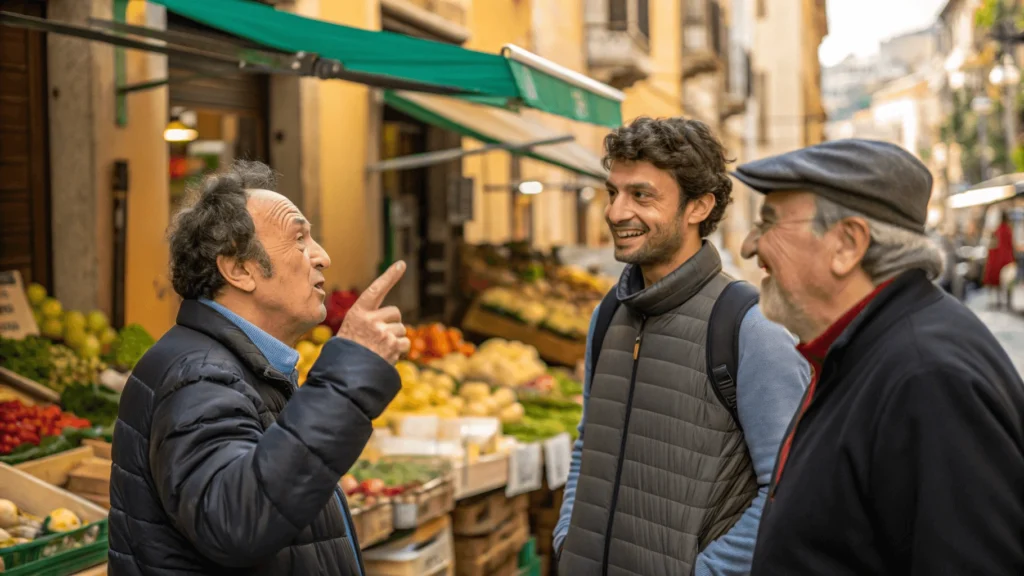
Italian dining culture has its own rhythm and rules:
Restaurant Protocol:
- Getting seated: “Un tavolo per [number], per favore”
- Ordering water: “Una bottiglia d’acqua [naturale/frizzante], per favore” (still/sparkling)
- Understanding course structure: Antipasti (appetizers), Primi (pasta/rice), Secondi (meat/fish), Contorni (sides), Dolci (desserts)
- Getting the check: “Il conto, per favore” – note that servers won’t bring it until you ask, For more insights into Italian dining customs and regional food etiquette, check out this cultural guide from the University of California’s Global Learning site.
Coffee Culture:
- Un caffè: An espresso (the default when you just order “un caffè”)
- Cappuccino: Only ordered before noon in Italy (locals consider milk drinks inappropriate after lunch)
- At the counter: “Un caffè, per favore” – pay first at most bars, then take receipt to the counter
Tipping: Unlike in America, tipping isn’t expected in the same way. A small “coperto” (cover charge) is often included. Rounding up the bill or leaving a few euros for exceptional service is sufficient.
Shopping
Italian markets and shops are a delight:
- Browsing: “Solo sto guardando” (I’m just looking)
- Asking prices: “Quanto costa questo?” (How much is this?)
- Bargaining: Only appropriate at street markets, not shops: “È troppo caro. Può fare un prezzo migliore?” (It’s too expensive. Can you offer a better price?)
- Sizes: Italian clothing sizes differ from US/UK systems. Know your Italian size beforehand or ask “Che taglia è?”
Safety & Emergencies
While Italy is generally safe, knowing emergency phrases is crucial:
- Medical emergency: “Ho bisogno di un medico” (I need a doctor)
- Police assistance: “Ho bisogno della polizia” (I need the police)
- Lost items: “Ho perso il mio [item]” (I’ve lost my…)
Emergency numbers:
- 112: European emergency number (works for all emergencies)
- 118: Medical emergencies
- 113: Police
Beyond the Basics: Enhancing Your Interaction
Once you’ve mastered the essentials, these additions will elevate your experience:
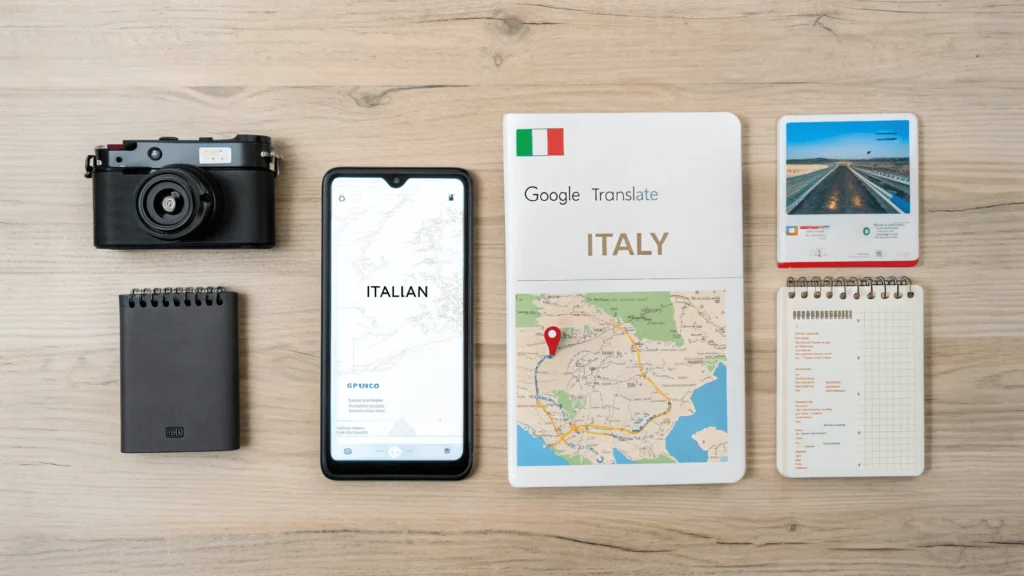
Conversation Starters
- “Di dove sei?” (Where are you from?)
- “È la mia prima volta in Italia” (It’s my first time in Italy)
- “Mi piace molto l’Italia” (I really like Italy)
- “Può consigliarmi un buon ristorante?” (Can you recommend a good restaurant?)
Understanding Italian Gestures
Italians communicate as much with hands as with words:
- The Pinched Fingers: Moving pinched fingers up and down can mean “What do you want?” or “What are you saying?”
- The Cheek Screw: Index finger rotating against the cheek means something is delicious
- The Chin Flick: Fingers brushing outward from under the chin signifies disinterest or dismissal
Using Translation Apps Effectively
While apps like Google Translate can be helpful:
- Download offline Italian packages before your trip
- Use the camera feature to translate menus and signs instantly
- Speak clearly and slowly when using voice translation
- Verify important translations with a human when possible – apps sometimes miss cultural context, For high-quality translations with cultural accuracy, many travelers prefer DeepL, a translation tool praised for its nuance and tone.
Essential Tools & Resources
Enhance your travel in Italian experience with these helpful resources:
- Language Apps: Duolingo, Babbel, or Memrise offer quick Italian lessons
- Translation Tools: Google Translate (download offline Italian before traveling) or DeepL for more nuanced translations
- Official Tourism Sites: Italia.it provides reliable travel in Italian information
- Train travel in Italian: Trenitalia for schedules and tickets
- Cultural Insights: Walks of Italy offers excellent articles about Italian customs and etiquette
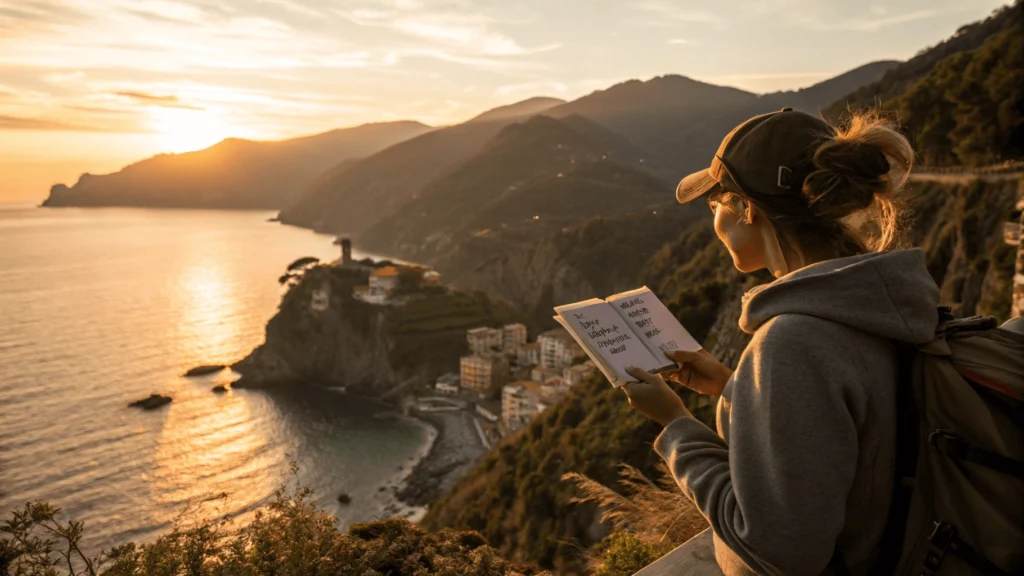
Conclusion: Embrace the Language, Enhance Your Experience
Learning to “travel in Italian” – both by speaking the language and understanding how to navigate the culture – transforms your Italian journey from a standard tourist experience into something more authentic and memorable.
Even mastering just a handful of phrases demonstrates respect for Italian culture and opens doors to warmer interactions. Locals appreciate the effort, even when your pronunciation isn’t perfect.
Remember that language mistakes often lead to your most charming and memorable travel in Italian stories. Don’t be afraid to practice your Italian – most Italians will be patient and appreciative of your attempts.
Buon viaggio! (Have a good trip!)
Have you had memorable experiences using Italian while traveling? Share your stories in the comments below!

